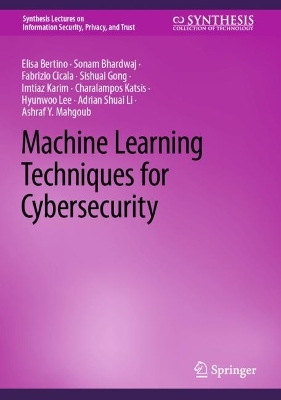Synthesis Lectures on Information Security, Privacy, and Trust
3 total works
As a fast-evolving new area, RFID security and privacy has quickly grown from a hungry infant to an energetic teenager during recent years. Much of the exciting development in this area is summarized in this book with rigorous analyses and insightful comments. In particular, a systematic overview on RFID security and privacy is provided at both the physical and network level. At the physical level, RFID security means that RFID devices should be identified with assurance in the presence of attacks, while RFID privacy requires that RFID devices should be identified without disclosure of any valuable information about the devices. At the network level, RFID security means that RFID information should be shared with authorized parties only, while RFID privacy further requires that RFID information should be shared without disclosure of valuable RFID information to any honest-but-curious server which coordinates information sharing. Not only does this book summarize the past, but it also provides new research results, especially at the network level. Several future directions are envisioned to be promising for advancing the research in this area.
Private Information Retrieval
by Xun Yi, Russell Paulet, and Elisa Bertino
Published 1 September 2013
This book deals with Private Information Retrieval (PIR), a technique allowing a user to retrieve an element from a server in possession of a database without revealing to the server which element is retrieved. PIR has been widely applied to protect the privacy of the user in querying a service provider on the Internet. For example, by PIR, one can query a location-based service provider about the nearest car park without revealing his location to the server.
The first PIR approach was introduced by Chor, Goldreich, Kushilevitz and Sudan in 1995 in a multi-server setting, where the user retrieves information from multiple database servers, each of which has a copy of the same database. To ensure user privacy in the multi-server setting, the servers must be trusted not to collude. In 1997, Kushilevitz and Ostrovsky constructed the first single-database PIR. Since then, many efficient PIR solutions have been discovered.
Beginning with a thorough survey of single-database PIR techniques, this text focuses on the latest technologies and applications in the field of PIR. The main categories are illustrated with recently proposed PIR-based solutions by the authors.
Because of the latest treatment of the topic, this text will be highly beneficial to researchers and industry professionals in information security and privacy.
The first PIR approach was introduced by Chor, Goldreich, Kushilevitz and Sudan in 1995 in a multi-server setting, where the user retrieves information from multiple database servers, each of which has a copy of the same database. To ensure user privacy in the multi-server setting, the servers must be trusted not to collude. In 1997, Kushilevitz and Ostrovsky constructed the first single-database PIR. Since then, many efficient PIR solutions have been discovered.
Beginning with a thorough survey of single-database PIR techniques, this text focuses on the latest technologies and applications in the field of PIR. The main categories are illustrated with recently proposed PIR-based solutions by the authors.
Because of the latest treatment of the topic, this text will be highly beneficial to researchers and industry professionals in information security and privacy.
Machine Learning Techniques for Cybersecurity
by Elisa Bertino, Sonam Bhardwaj, Fabrizio Cicala, Sishuai Gong, Imtiaz Karim, Charalampos Katsis, Hyunwoo Lee, Adrian Shuai Li, and Ashraf Y. Mahgoub
Published 9 April 2023
This book explores machine learning (ML) defenses against the many cyberattacks that make our workplaces, schools, private residences, and critical infrastructures vulnerable as a consequence of the dramatic increase in botnets, data ransom, system and network denials of service, sabotage, and data theft attacks. The use of ML techniques for security tasks has been steadily increasing in research and also in practice over the last 10 years. Covering efforts to devise more effective defenses, the book explores security solutions that leverage machine learning (ML) techniques that have recently grown in feasibility thanks to significant advances in ML combined with big data collection and analysis capabilities. Since the use of ML entails understanding which techniques can be best used for specific tasks to ensure comprehensive security, the book provides an overview of the current state of the art of ML techniques for security and a detailed taxonomy of security tasks and corresponding ML techniques that can be used for each task. It also covers challenges for the use of ML for security tasks and outlines research directions.
While many recent papers have proposed approaches for specific tasks, such as software security analysis and anomaly detection, these approaches differ in many aspects, such as with respect to the types of features in the model and the dataset used for training the models. In a way that no other available work does, this book provides readers with a comprehensive view of the complex area of ML for security, explains its challenges, and highlights areas for future research. This book is relevant to graduate students in computer science and engineering as well as information systems studies, and will also be useful to researchers and practitioners who work in the area of ML techniques for security tasks.
While many recent papers have proposed approaches for specific tasks, such as software security analysis and anomaly detection, these approaches differ in many aspects, such as with respect to the types of features in the model and the dataset used for training the models. In a way that no other available work does, this book provides readers with a comprehensive view of the complex area of ML for security, explains its challenges, and highlights areas for future research. This book is relevant to graduate students in computer science and engineering as well as information systems studies, and will also be useful to researchers and practitioners who work in the area of ML techniques for security tasks.


